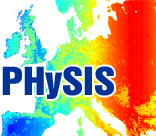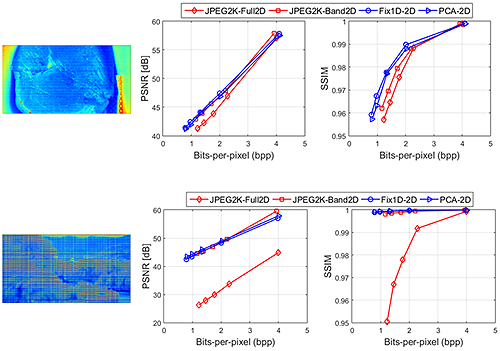Spectral Mosaic Compression |
Recent achievements in hyperspectral imaging (HSI) demonstrated successfully a novel snapshot mosaic sensor architecture, enabling spectral imaging in a truly compact way. Integration of this new technology in handheld devices necessitates efficient compression of HSI data. However, due to the specific mosaic structure of the acquired images, traditional compression techniques tailored to full-resolution HSI data cubes fail to exploit the special spatio-spectral interrelations among the pixels. |
|
Motivated by the spatio-spectral properties of multiple-input multiple-output (MIMO) antenna arrays, an appropriate spatio-spectral decorrelator is designed, which adapts to the specific arrangement of the filters on the mosaic sensor, thus it is computed only once for a given SSM sensor. Then, we employ a hybrid approach by first compressing across the spectral dimension, followed by a two-dimensional spatial compression of the transformed spectral bands. The experimental evaluation reveals for a given bits-per-pixel budget, our proposed method (Fix1D-2D) exhibits a better reconstruction performance when compared against the following state-of-the-art methods designed for full HSI data cube compression: a transform coding method (JPEG2K-Band2D), which first reshapes the original mosaic image into separate spectral bands and then compresses the 3D data cube by applying a hybrid 1D(spectral)-2D(spatial) discrete wavelet transform (DWT); 2) a hybrid 1D-2D compression method (PCA-2D) similar to JPEG2K-Band2D, which first decorrelates the spectral vectors using PCA and then applies JPEG2000 for 2D spatial compression. As we expected, the naive approach (JPEG2K-Full2D), which applies JPEG2000 compression to the original 2D mosaic image, achieves the worst compression performance, due to the limited spatio-spectral redundancies among the pixels of the mosaic image. |
In order to increase the adaptivity to the inherent spectral relations, the above method has been extended towards achieving an improved decorrelation performance, and subsequently higher compression ratios. To this end, a dictionary learning step is incorporated based on the framework of Adaptive Morphological Component Analysis (AMCA), in order to design an adaptive spectral representation. Due to the increased computational cost of AMCA, this compression technique is suitable for HSI imaging systems with increased computational resources. |
Achievements





